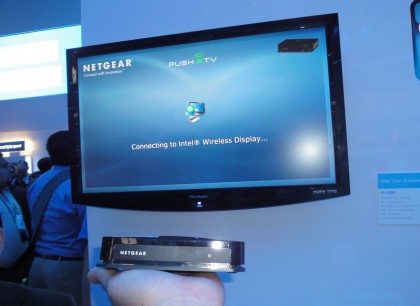The thrill associated a FCC discovery was quickly replaced by a more reserved reaction, and I intended to pass on Netgear’s Push2TV CES announcement with Intel (despite taking photos). However, given the number of incoming questions and some imminent news, I’m running with it.
First, CNET reports that the Netgear Push2TV unit is the first retail device to feature WiFi Direct – which eases wireless device-to-device connections. In this case, allowing select Intel-powered laptops to beam the contents of their display, along with audio, to the television of your choice.
Additionally, Netgear’s Intel Wireless Display implementation runs a mere $100… or less, keep reading. After corresponding with Netgear’s wireless product manager this week, I’ve learned that Best Buy will begin selling three laptops (Toshiba, Dell, and Sony) tomorrow, comprised of the appropriate 2010 Intel processors, Intel WiFi, and Intel graphics along with a bundled Push2TV unit.
Despite the basic functionality of Push2TV, which lacks two-way remote control or the ability to select specific regions of the screen for broadcast à la SlingCatcher, at $100 (or free!) Netgear’s solution is an inexpensive and efficient method to gather the family around the television for Hulu or vacation photo viewing.
Click to enlarge:

I’m not entirely sure, but given my correspondence, it sounds like the hardware requirements/restrictions may be eased at some point allowing Push2TV to work with a broader range of laptops. Which would be good, because I’d like to take a look at this thing on my Core 2 Duo Macbook running Vista or Windows 7.
I updated the post with a capture (bottom right) of today’s circular that lists the bundling of Netgear’s Push 2 TV adapter with select Intel-based laptops.
And a third update! The Wi-Fi Alliance’s PR agency has let me know that this product has not been certified as a Wi-Fi Direct product. It may or may not use the tech and follow the specs, but the Alliance won’t begin certifying products (presumably at a cost to carry that brand/designation) until mid-year.
Like you I’d actually really like to use this product, but am not about to buy a new laptop to get it. I think its great that Intel is building it into laptops, so it’ll be built into some future laptop I purchase (or perhaps an Apple Tablet), but in the interim there really needs to be support for the usual USB dongles and such to add this to existing laptops. If you need a high-end CPU to run the software needed, so be it. But if Intel is thinking this thing will get built into TVs based solely on its support in a few laptops, they’re dreaming. It needs to be a standard across multiple manufacturers for this to work.
If the market for this was open, you’d see projectors using this to replace VGA cables, TVs with this stuff built in, USB and CardBus transmitters available from various companies driving prices down, etc etc. We’ll see…
After downloading the PDF manual from the website, the more troubling issue for me is the “not recommended for more than four hours of use” disclaimer under troubleshooting tips for the TV screen blacking out due to heat issues. (Turn the adapter off until it cools down). If the case needs to be bigger for proper ventilation and includes a heatsink for key components to control heat, maybe it’s back to the drawing board for this product.
I have been browsing online more than three hours today, yet
I never found any interesting article like yours.
It is pretty worth enough for me. In my opinion, if all site
owners and bloggers made good content as you did,
the net will be a lot more useful than ever before.
|
I couldn’t resist commenting. Perfectly written!|
Great website, maybe we can share links?